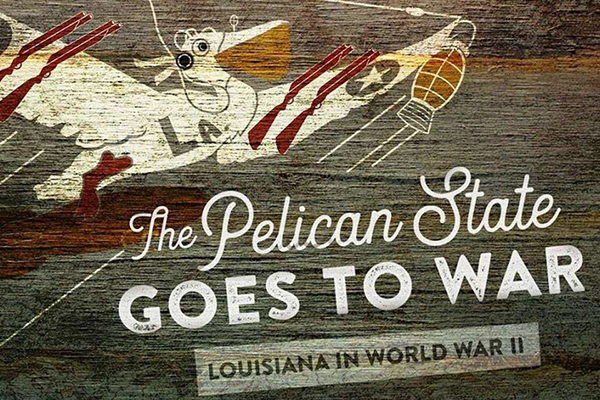A collection of artifacts, oral histories and photos at the University of Louisiana at Lafayette’s Edith Garland Dupré Library recognizes the state’s contributions during World War II.
“The Pelican State Goes to War: Louisiana in World War II” traveling exhibit was created as a tribute to the nearly 280,000 state residents who served in the U.S. military during the global conflict. The National WWII Museum in New Orleans produced it.
The exhibit can be viewed until Aug. 27 in the main hallway of Dupré Library’s first floor, 400 E. St. Mary Blvd. Notable Louisianans who served in the military, industry contributions to the war effort, and the state’s role as a training hub are among the highlights.
The exhibit includes information about the six World War II Medal of Honor recipients born in Louisiana. They include Marine Col. Jefferson DeBlanc, ’47, one of two University alums to have earned the U.S. military’s highest award for valor during combat. The other, Air Force Capt. Steven Bennett, ’69, served during the Vietnam War.
The exhibit also spotlights Louisianans such as Air Force Maj. Gen. Claire Lee Chennault and Army Lt. Col. Richard English. Chennault, who led the fabled “Flying Tigers” squadron of pilots, developed a system to warn China of impending air attacks. English was a New Orleans educator who joined the “Black Panthers” – the segregated 761st Tank Battalion. He spent three decades ensuring the battalion received the Presidential Unit Citation it was finally awarded in 1978.
World War II began in 1939 and ended in 1945. The United States joined Allied Forces against Axis powers on Dec. 8, 1941, the day after Japan launched air attacks on the U.S. naval base at Pearl Harbor, Hawaii.
War efforts in Louisiana, as the exhibit points out, were already well underway. The state was the site of the largest maneuvers in U.S. military history and hosted hundreds of thousands of troops between 1940 and 1945.
Factories and refineries in Louisiana did their part, too, producing equipment and supplies that, by war’s end, included billions of gallons of aviation fuel and about 20,000 “Higgins” boats. The specialized boats, named for their creator, Andrew Higgins of New Orleans, were designed to carry troops onto land. The vessels transported soldiers to the beaches at Normandy, France, on June 6, 1945, during the Allied invasion known as D-Day.
Other elements of the exhibit – DeBlanc’s efforts over the South Pacific in January 1943, for example – illustrate World War II’s ties to campus. The fighter pilot downed several enemy planes during an escort mission. After DeBlanc’s aircraft was hit, he parachuted to sea and swam for hours to a Japanese-occupied island. DeBlanc hid in the jungle for five days before being discovered by friendly islanders and reunited with the U.S. Navy.
Not every item in the exhibit tells of good outcomes.
A letter by Dr. Joel L. Fletcher, then-University president, serves as a stark reminder that many people – including 4,987 Louisianans, according to the National WWII Museum – didn’t return from the war.
Fletcher was among several civic leaders who offered sympathy to Mrs. Norbert Larriviere of Youngsville, La., after her son, Sidney Larriviere, became the first Louisiana service member killed during World War II.
Larriviere was aboard a U.S. Navy destroyer patrolling a neutral zone in the North Atlantic Ocean on Oct. 17, 1941, several weeks before the Pearl Harbor attacks. He and 10 other service members died after the ship was struck by a torpedo fired from a German U-boat.
The last lines of Fletcher’s letter to Larriviere’s mother, dated three days after the event, read: “Please accept my deepest sympathy in your sorrow. I hope that the time will come when mothers like you will not have to make such sacrifices.”
Learn more about Edith Garland Dupré Library and the National WWII Museum.
Image caption: A traveling exhibit produced by the National WWII Museum that recognizes Louisiana’s contributions during World War II will be displayed at UL Lafayette’s Edith Garland Dupré Library until Aug. 27. Image credit: Courtesy of The National WWII Museum
